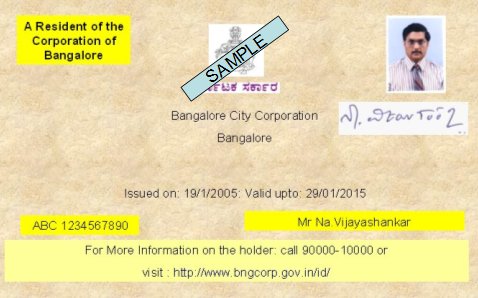Today, people swear by the term “Innovation”. Whether it is the Budget Speech or a Chairman’s speech in AGM, the buzz word is “Innovation”.
However people who actually innovate often wonder why some thoughts get the tag of innovation and some fail to.
Today, I saw a report in Times of India that in Bangalore the BBMP may issue “Property ID Cards” for every property. (See Report here).
This reminded me of the exact proposal I had made to BBMP long long time back which was then not appreciated.
I was also reminded of an article titled “The National ID Card Challenge for Nandan Nilekani.. Part I : Part II : This should have been a sensational news when presented but did not attract the attention of any.
As of today, people need to appreciate the idea of property ID as presented by BBMP as “innovative” and welcome it.
But it is necessary to point out that more than 10 years back, this proposal was made by the undersigned as part of the implementation of the “DVIIS” or the “Digital Value Imprinted Instrument System” (Refer this 2003 post). The concept was subsequently put to suggested harnessing in the name of “ZeMo” cards or “Zero Memory Smart Cards”
The concept was a universal concept with use cases in “Citizen Identity”, “Digital Stamps”, “Prepaid Cards”, “Air and Bus Tickets”, “Digital Cheques”, and several other instances including “Property IDs”. The idea was discussed with several Government agencies including the BBMP officials and Banks. Several of the IT companies some of whom are today MNCs and claiming to be “Innovators” could not appreciate the worth of the suggestions despite explaining of the entire concept in clear terms. If I check my e-mails, many of the “Who Is Who leaders” of today are people who could not see the potential of the innovative idea which today is seen in every IT project including the Aadhaar Card and Digital Payment Systems.
I still remember that Stock Holding Corporation was in the verge of implementing their Digital Stamps system at that time and when our solution was presented to them (see here the basic concept) we were told, “We would have taken up your solution but one of our executives has given a promise to another vendor”. The Karnataka Government of that time had also been approached and did not perhaps understand the benefits.
Companies like Cognizant considered the ideas in the Banking product area for some time but again was unwilling to pick it up as a product and wanted to consider it only if some Bank could give them the project. Banks of course were not capable of themselves taking a decision on a disruptive idea unless it is presented to them by a large IT company. Neither the Government agencies nor the senior IT executives of that time had the ability to understand and appreciate the thought and convert it into a commercial products though the undersigned had not placed any IPR barriers.
It is amusing that 13 years after the idea was first published, we are seeing that one by one all the use case instances of Digital Value Imprinted Instrument System and the “ZeMo Cards”.
Probably some of the suggestions I am discussing now will be considered “Innovative” 10 years down the lane.
I wonder if a 10 year old idea is “Innovative today” what was it 10 years back?.
……………Probably we should call it “Futuristic”? or “Innovation too early for the time?”
It is therefore necessary for Innovators looking for success to understand that even if an innovation is considered a “Disruptive Innovation”, it will only get recognized if the society is mature enough to understand the disruptive nature of the idea.
Otherwise it is necessary to wait until the society matures to a level when your “Too early to understand idea” is recognizable as “Disruptive and Innovative”.
But the thought lingers on….
If an innovative disruptive thought of today is a potential winner backed by venture capitalists and policy makers, should they not be mature enough to understand that a “Futuristic idea” which may become disruptive and innovative over a time is also a “Potential Winner” probably at a higher scale?
Even if they are not mature today, I hope they will mature in time when they reflect, “How Did I miss to recognize and back this innovation when this was presented 10 years back?”
With this positive thought, I urge “Futuristic innovators ” to continue to do what they know best…
“Ignore the current appreciation or lack of it, continue to innovate even if it takes another decade for the society to understand and appreciate”
Naavi








